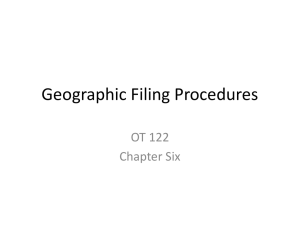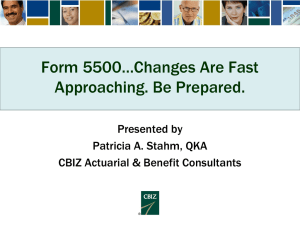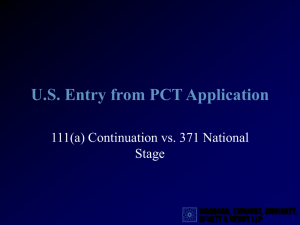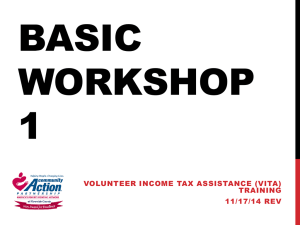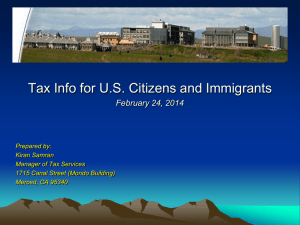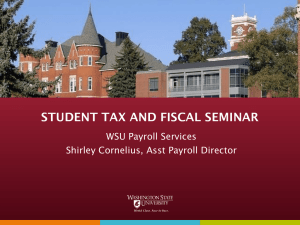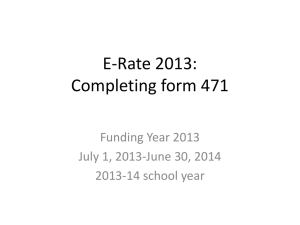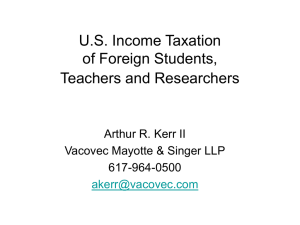Form 5500-EZ
advertisement
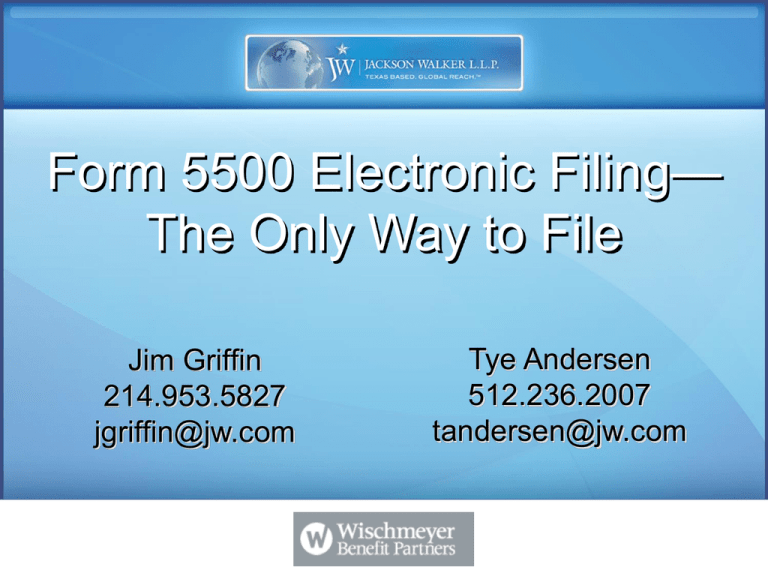
Form 5500 Electronic Filing— The Only Way to File Jim Griffin 214.953.5827 jgriffin@jw.com Tye Andersen 512.236.2007 tandersen@jw.com Overview Part I: Review of the Basics Part II: Form 5500 Revisions Part III: EFAST2 PART I Review of the Basics What is Form 5500? The Form 5500 annual return/report is used to report information concerning employee benefit plans to: • IRS • DOL • PBGC What employee benefit plans must have a Form 5500? Every pension benefit plan Every welfare benefit plan How many plans can be included within each Form 5500? One Form 5500 is generally required for each plan Can several benefit arrangements be included within one plan for Form 5500 filing purposes? Plan sponsors can offer benefits through various structures and combinations Governing documents and actual operations must be reviewed to determine whether welfare benefits are being provided under a single plan or separate plans Having separate insurance policies for each different welfare benefit does not necessarily mean that the employer has separate plans What is a wrap plan? A document that incorporates various benefits and insurance policies into one comprehensive plan What is a plan number and how is it assigned? Plan numbers are self-assigned by the employer For pension benefit plans, start at 001 for the first plan and then consecutively number other plans as 002, 003, etc. For welfare benefit plans, start at 501 for the first plan and then consecutively number other plans as 502, 503, etc. Once you use a plan number for a plan, continue to use it for that plan on all future filings with IRS, DOL and PBGC Do not re-use a plan number even if the plan is terminated. What is the Form 5500 filing status of a plan that covers employees of a parent corporation and its subsidiaries? Multiemployer Plan—No Multiple-Employer Plan—No Single-Employer Plan--Yes What are pension benefit plans? Profit sharing, stock bonus, money purchase and 401(k) plans 403(b) plans Defined benefit plans Cash balance plans Are any pension benefit plans excluded from filing Form 5500? Governmental plans Church plans SIMPLE plans funded with SIMPLE IRAs SEP Top hat plans that benefit a select group of management or highly compensated employees but only if a registration statement is timely filed with DOL What are welfare benefit plans? Medical Dental Life insurance Apprenticeship and training Scholarship funds Severance pay Disability Are any welfare benefit plans excluded from filing Form 5500? Welfare benefit plans that covered fewer than 100 participants as of the beginning of the plan year and are: • Unfunded • Fully insured • A combination of insured and unfunded Governmental plans Church plans What is the 80/120 rule? If the number of participants that is reported on Line 6 of Form 5500 is between 80 and 120, and a Form 5500 was filed for the prior plan year, the employer may elect to complete the Form 5500 in the same category (“large plan” or “small plan”) as was filed for the prior year Form 5500. When does an employee become a participant? For welfare benefit plan purposes, an employee becomes a participant on the earlier of: • The date specified in the plan document • The date the individual becomes eligible for a benefit, subject only to the occurrence of a contingency for which the benefit is provided • The date the individual makes a contribution to the plan, whether voluntary or mandatory What is an unfunded plan? Benefits are paid as needed directly from the general assets of the employer that sponsors the plan Plans that are not “unfunded”: • Plans that receive employee contributions • Plans that use a trust to hold plan assets Plans are “unfunded”: • Plans with employee contributions that are associated with a cafeteria plan • Plans with COBRA premiums Schedule A information If an insurance company refuses to provide information for Schedule A, ER should report the refusal on line 2a of the Schedule A Administrative services only (ASO) contract An ER should not file a Schedule A for an ASO contract In a self-insured health plan, ERs often contract with an insurance company to process claims However, insurance company is acting as a service provider and is not insuring the benefits Stop loss contracts ERs with self-insured welfare plans may purchase stop loss policies to help them manage the risk If premiums are paid out of the ER’s general assets, the contracts are not reported on Schedule A Financial Schedules I – Small Plans H – Large Plans When is the Form 5500 due? All required forms, schedules, statements and attachments must be filed by the last day of the 7th calendar month after the end of the plan year that began in 2009 July 31, 2010 for calendar year plans Next business day if the filing deadline is on a Saturday, Sunday or Federal holiday; August 2, 2010 What is the plan year? 12 month period Set out in plan document or SPD Policy year Calendar year Can the due date of Form 5500 be extended? File Form 5558 before the Form 5500 filing deadline to obtain an extension of up to 2 ½ months October 15, 2010 www.irs.gov Are other extensions possible? An automatic extension of the Form 5500 filing deadline will be granted until the due date of the employer’s Federal income tax return if: • The plan year and the employer’s tax year are the same • The employer has been granted an extension of time to file its Federal income tax return • A copy of the application for extension of the time to file the Federal income tax return is attached to the Form 5500 September 15, 2010 Are there any more extensions? Special extensions under certain circumstances Presidentially-declared disaster areas What penalties apply if a Form 5500 is filed late? $1,100 a day for each day that a plan administrator fails or refuses to file a complete Form 5500 $25 a day (up to $15,000) for not filing returns required to be filed with IRS Willful violation of ERISA—fine of not more than $100,000 or not more than 10 years in prison or both Making any false statement or representation of fact, knowing it to be false, or for knowingly concealing or not disclosing any fact required by ERISA—fine of not more than $10,000 or 5 years prison or both Audit not completed File 5500 timely • With draft of audit or an explanation of why audit not completed When completed, file amended 5500 DOL may assess $50,000 penalty Is there any way to reduce the penalties? Delinquent Filer Voluntary Compliance Program http://www.dol.gov/ebsa/FAQs/faq_DFVC.html What other penalties apply to Form 5500? Under penalties of perjury and other penalties set forth in the instructions, I declare that I have examined this return/report, including accompanying schedules, statements and attachments, as well as the electronic version of this return/report if it is being filed electronically, and to the best of my knowledge and belief, it is true, correct and complete. Who is the Plan Administrator? The person specifically so designated by the terms of the instrument under which the plan is operated If an administrator is not so designated, the plan sponsor In the case of a plan for which an administrator is not designated and a plan sponsor cannot be identified, such other person as the Secretary may by regulation prescribe. Fidelity Bond Every plan official who handles plan funds must be covered under a fidelity bond Certain exemption for banks and insurance companies Fiduciary liability insurance is not reported on line 4e (Sch. H or I) How long should I keep previously filed Form 5500s? All plan-related materials should be kept for a period of at least six years after the date of filing of an ERISA-related return or report, and the materials should be preserved in a manner and format (electronic or otherwise) that permits ready retrieval All records that support the plan’s annual reporting and disclosure should be retained for the same period of at least six years PART II Form 5500 Revisions 2009 Forms Revisions Facilitate move to fully electronic filing system. Streamline and simplify small plan filing. Better disclosure on plan fees & expenses. Includes Pension Protection Act (PPA) reporting changes first required in 2008. New Form 5500-SF Two Page “Short Form” 5500 for Small plans (under 100 participants). Can use if: • Exempt from annual audit requirement; • 100% invested in secure investments that have a readily determinable fair value; • Hold no employer securities; and • Not multiemployer plan. No Schedules required except DB plans required to file actuarial schedule. NOTE: IRS giving many 5500-EZ filers choice of e-filing 5500-SF with EFAST or paper 5500-EZ with IRS. Form 5500 Revisions IRS-only Schedules (E, SSA) removed to enable mandatory e-filing. Enhanced disclosures on plan fees & expenses. Put 403(b) plans on par with 401(k) plans. Better info on DB pension funding and multiemployer plans (including PPA changes). Focused compliance questions added. Questions & instructions clarified/improved. New Schedule C Reporting Identify each service provider who received $5,000 or more in comp (direct & indirect). Includes new codes describing services & types of compensation. Report total direct comp paid by plan separately from total indirect comp received by provider. Prior rule requiring plan to identify only top “40” highest paid service providers is eliminated. Schedule C Guidance Two Sets of Frequently Asked Questions available on EBSA website to help filers apply the instructions Forms and instructions Preamble to Notice of Adoption of Final Forms Revisions Small Plan Fee and Expense Reporting Schedule I filers not subject to Schedule C indirect compensation reporting rules. Must break out fees on Schedule I paid directly by plan to administrative service providers. Small plans filing Schedule A must still report information on insurance fees and commissions. Short Form has questions on direct compensation paid by plan and insurance fees & commissions. New Compliance & Technical Questions Whether plan paid benefits when due. Whether plan complied with blackout notice regulations. New feature codes for plans with automatic enrollment or default investment options. Standard supplemental schedule for Schedule H reporting delinquent participant contributions. No EFAST Correspondence Under New System Filers and service providers/submitters should pay close attention to the EFAST2 automatically generated list of errors/warnings. Filers will no longer receive post-filing written correspondence from EFAST requesting voluntary corrections of errors/incomplete filings within 30 days. 5500-EZ Form 5500-EZ (paper return) must be filed by – • Any one-participant plan, unless the plan is eligible to file and chooses to file Form 5500-SF electronically thru EFAST2, or the plan is not required to file a return because the plan has assets (alone or in combination with the employer’s other one-participant plans) of $250,000 or less at the end of the PY and the return is not for the final PY. Form 5500-EZ One-participant plan means: • Plan covers owner/owner & spouse and owner/owner & spouse own entire business, whether incorporated or unincorporated; or • Plan covers one or more partners/partners and spouses of a partnership. • Plan does not provide benefits for anyone except owner/owner & spouse or partner(s)/partner(s) & spouse(s). Form 5500-EZ One-participant plan is eligible to file Form 5500-SF electronically thru EFAST2 if: • Plan is a one-participant plan as defined earlier, and • Plan covered fewer than 100 participants at the beginning of the PY. One-participant plan filers of Form 5500SF complete only those parts of the form that correspond to Form 5500-EZ. Form 8955-SSA Schedule SSA (Form 5500) removed from the Form 5500 series New, stand-alone 2009 form being established Do not file with the Form 5500 using EFAST2 Retain Paper Copy Plan administrators must maintain an original of the Form 5500 with all required signatures as part of their records Extension of Time to File No longer required to attach a copy of Form 5558 Now, merely check the box on 5500, and if applicable, enter a description of the special extension Form 5500 One-participant plan may not file an annual return on Form 5500 for 2009 New plan characteristic codes have been added to line 8 Plan characteristic code 3E has been removed Code 3D will identify all pre-approved pension plans for 2009 Feature codes for certain types of plans have been eliminated Schedule A A new Part IV has been added for plan administrators to report insurance companies that fail or refuse to provide the information necessary to complete Schedule A Schedule C On Schedule C, you must now report all service providers who receive $5,000 or more in direct or indirect compensation Schedule H Line 2b(2)(C) has been added for reporting dividends on registered investment company shares (mutual fund) Schedule H and I A new standardized schedule is now provided for reporting delinquent participant contributions on line 4a Line 4(l) has been added to report whether the plan failed to provide any benefit when due Lines 4(m) and 4(n) added to report a blackout PART III EFAST2 Electronic Filing with EFAST2 Two ways to create & submit filings: • 3rd Party Certified Software • IFILE (free web-based filing application) Combinations OK List of approved third party software is posted at www.efast.dol.gov Electronic Filing Mandate All Form 5500 and Form All Form 5500 and Form 5500-SF must be submitted through EFAST2 except filings which have a plan year begin date in 2008 may be submitted on paper through EFAST. This includes plan year 2007 and prior returns/reports. See EFAST2 FAQ #4. EFAST2 Help EFAST2 website at www.efast.dol.gov • FAQs • Users guides • Web-based tutorial Staffed help desk at 1-866-GO-EFAST during business hours Third party software certification & support Using EFAST2 Register for credentials Create a filing Check the filing for errors Sign the filing Submit the filing and check the status View filings on DOL website Register for Credentials All plan sponsors & administrators must register for credentials to sign filings (Filing Signer role) Anyone wishing to fill out the forms/schedules through IFILE must register for credentials to author (Filing Author or Schedule Author role) Anyone wishing to transmit completed filings through third party software MAY need to register for credentials (Transmitter role) Actuaries and accountants do not need to register but may do so if they wish You can not use EFAST credentials for EFAST2 Summary of Steps to Register Go to www.efast.dol.gov and click “Register” Enter contact information and select role Follow the screens Check your email (and spam folder) for a message from EFAST2 Click on the link in the EFAST2 message to complete your registration Keep track of your UserID and password Register – 1st Screen Register – 2nd Screen Register – 2nd Screen (Continued) Register – 3rd Screen Register - Email Register - Verification Register – PIN Agreement Register – Signature Agreement Register - Final Registration Tips Use your business email address when registering, rather than your personal address. Check your spam folder if you do not receive the EFAST2 email within 5 minutes. You can change your addresses (including email), phone number, PIN, Password, and roles at any time. Just login to the website and click “User Profile”. You can not modify the UserID or secret knowledge (place or date of birth). This may change in the future. Your Personal Identification Number (PIN) is personal and not to be shared. Create a Filing IFILE is a free, optional, ‘no-frills’ web based filing application available on the EFAST website Approved third party software should provide filers with added value Must obtain “Filing Author” credentials before creating a filing in IFILE Summary of Steps to Create a Filing in IFILE Go to www.efast.dol.gov portal and click “Login” Click “Create a Filing” Select the form year & type you want to complete Provide a name for your filing (only for your use, does not get sent to Gov’t) Complete the form Add schedules and attachments as needed Validate the filing to see if there are errors IFILE - Homepage Create a Filing – Form 5500 IFILE Workspace Add Attachment Validating a Filing Validating a Filing – List of Errors Filing Creation Tips You can view or print the filing at any time to see it in the “forms”. Follow the forms instructions, consider printing these out before you start. Don’t forget to Validate and correct errors. Call the help desk if you need assistance. You don’t need to include the Form 5558 extension as an attachment in your filing. NEVER include Schedule SSA, Form 8955-SSA, or social security number in your EFAST2 filing. Don’t scan paper unless you must to minimize the filing size. Sign the Filing Signatures can be applied through approved third party software or IFILE. Needed signatures are specified in Form 5500 and 5500-SF instructions. Signatures in EFAST2 mean UserID and PIN. One process for signing filings in iFile; one size fits all. Summary of Steps to Sign a Filing in IFILE Associate Signers • Open/Import a filing in iFile • Click associate signers • Enter one or more registered filing signer’s email address Apply Signature • Signer opens the filing in iFile and reviews the filing • Click sign filing • Enter UserID & PIN and select signature line Associating a Signer Specifying Registered Signer(s) Signer(s) E-mail Notification Signer Summary (Notification) Sign Button Signature Legal Language Application of Signature Signature Tips Individuals must have registered as signers before you can associate them to a filing and email address must match in IFILE. If a required signature is missing you will receive a message AFTER you submit the filing – it won’t show up in the Validation check before you submit. If the plan administrator signature is missing or incorrect, you will get a “STOP” message when you submit your filing. If plan administrator is same as plan sponsor, that person only needs to register once and apply their signature to the plan administrator “line”. Submitting a Filing EFAST2 automatically receives and tests filing submissions. 100MB is the current file size limit. Filers will see an initial list of errors/warnings if they validate before submission. Filers should receive an acknowledgment ID after submitting. Filers must check the status of their filing and final errors/warnings after receiving the acknowledgement ID. Filing status that includes the word “unprocessable” means we did not receive a filing from you. See EFAST2 FAQ #38. In IFILE, only the author can submit filings. Summary of Steps to Submit a Filing in IFILE Open the signed filing in iFile. Click Submit. Click OK in the Acknowledgement popup window. In the left hand navigation bar, click Submissions. See the Status of the filing you submitted (click if possible) to ensure EFAST2 received and could process what you sent. Ready for Submission Submitting a Filing List of Submitted Filings Submitting Filing Tips Check the filing status and list of errors after you submit (may differ from the prevalidation you did before you submitted). If you are amending or want to make a copy of a filing, use the “amend” button in the submission list window. General Consideration when Using EFAST It’s a first-year Internet-based web application, it’s not bullet-proof. • If your Internet connection is fast, you will have a better experience. • If you click something and it doesn’t do what you expect or your screen freezes, close your browser and try it again. Don’t get frustrated, help is available. • Use the information and guides on our website. • Call the help desk (1-866-463-3278) 8:00 a.m. to 8:00 p.m., Eastern Time, Monday through Friday, except for federal holidays.
